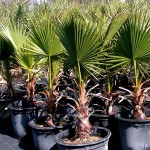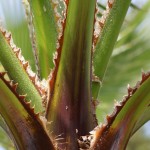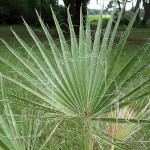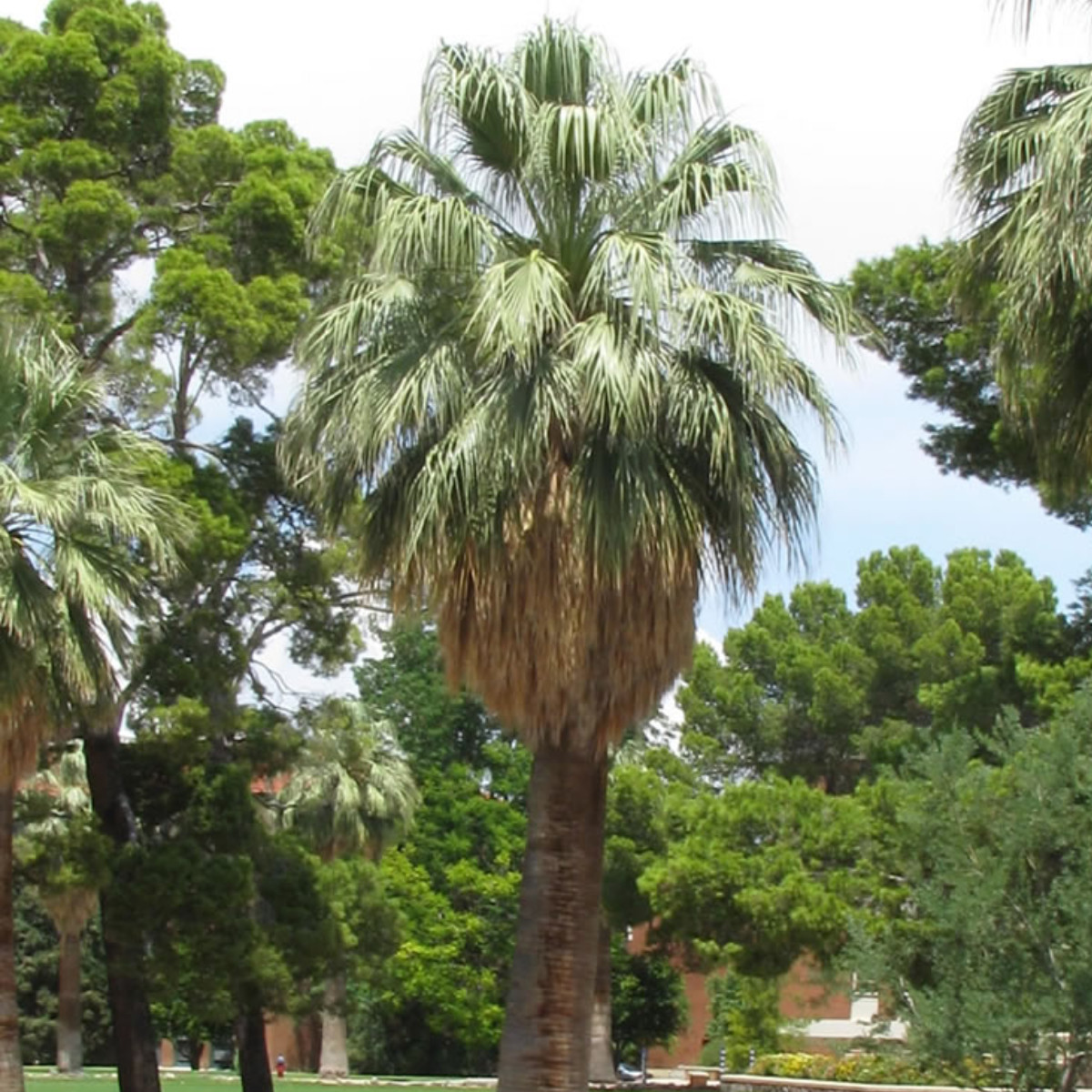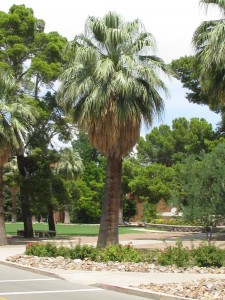Family: Arecaceae
Synonymous: Brahea filamentosa
Brahea filifera
Neowashingtonia filamentosa
Neowashingtonia filifera
Pritchardia filamentosa
Pritchardia filifera
Washingtonia filamentosa
Washingtonia filifera var. robusta
Distribution and habitat: Washingtonia filifera is the only palm native to the Western United States. They are found in desert riparian habitats at spring-fed oases in the Colorado Desert (Low Desert) and throughout a major portion of the Mojave Desert. It is also found near watercourses along the Colorado River and several other isolated locations in Nevada. It is a naturalized species in the warm springs near Death Valley and in the extreme northwest of Sonora (Mexico) and also in Florida and the U.S. Virgin Islands.
Description: Washingtonia filifera have a short, tapered, mahogany red trunks and long, spiny leaf stalks which carry large fan-shaped leaves which are cut into about twenty segments for up to half of their spread. A distinctive feature of most of these popular palms is the fine fibres which hang from the edges of the leaf divisions.
Washingtonia filifera has an open, uncluttered look. Its grey-green leaves have a span of about 60cm (24 inch) or more. The spiny leaf-stalk are about 45cm (18 inch) long, flat and mostly green.
Washingtonia filifera produces (but not indoors) numerous branching flower clusters that project out and often downward from the leaf crown. The bisexual blossoms are white and yellow and give rise to oblong or round red-black fruit, each about a 1.3cm (0.5 inch) in diameter. The fruits of Washingtonia filifera contain a single seed, approximately 0.6cm (0.25 inch) in diameter.
Washingtonia filifera can live from 80 to 250 years or more.
Houseplant care: Washingtonia filifera is easy to grow as indoor plant. Washingtonia filifera species grow in the wild in widely different environments where they have adapted to a broad range of temperatures and another conditions.
Light: Washingtonia filifera needs bright light throughout the year, including, if possible, several hours of direct sunlight every day to ensure healthy, attractive growth. Most growth is generally made during the summer months and adequate light during this period helps to produce large leaves of good colour. If these palms get too little light, they may shed one or more lower leaves.
Temperature: Though they prefer warm or even hot rooms, these plants can tolerate occasional temperatures as low as 10C (50F). Washingtonia filifera can also tolerate rather dry air conditions, but they will produce larger leaves of a better colour if they are stood on trays or saucers of pebbles kept moist.
These palms will do best if they are moved to a sheltered position outdoors (a sheltered patio or courtyard is ideal) from early summer to autumn.
Watering: During the active growth period water Washingtonia filifera plentifully as often as necessary to keep the potting mixture thoroughly moist, particularly if plants are kept close to a sunny window; but never allow the pot to stand in water.
During the winter rest period water more moderately, enough to moisten the potting mixture throughout, but permitting the top centimetre (0.4 inch) or so of the potting mixture to dry out before watering again.
Feeding: Apply standard liquid fertiliser every two weeks during the active growth period.
Potting and repotting: Because a water-retentive potting mixture is essential for these plants, add one third rotten leaf mould or peat moss to a standard soil based mixture. For good drainage put plenty of clay-pot fragments in the bottom of the pot. Repot these palms only when their roots are active - during the active growth period. They do not like to be overpotted, so do not move them into pots one size larger until light coloured roots appear in quantity on the surface of the potting mixture. The surface of potting mixture will be densely covered with brittle roots, needing careful treatment. This should occur no more than once in two to three years. It is very important to plant Washingtonia filifera firmly, taking special care not to damage the main (thicker) roots, which are brittle; These plants are unusually sensitive to root damage.
Gardening: Washingtonia filifera is cold hardy, has a fast to moderate growth rate and it drought and salt resistant. If old leaves are not removed, they form a continuous "petticoat" from the crown all the way to the ground.
Plant Washingtonia filifera outdoors in a site that can accommodate the large head of leaves and is not directly under power lines or other structures.
Established Washingtonia filifera palms can withstand temperature down to about minus 9-6C (15-20F) frosts and freezes, recovering quickly from the damage. Palms in fast-draining soil are more cold hardy.Washingtonia filifera can also withstand extreme heat, including temperatures up to 53C (127F).
Position: Washingtonia filifera prefers exposure to full sun and even quite small specimens will thrive in full sun. It also grows well in part sun/shade.
Soil: The Washingtonia filifera requires well-draining soil. Compost rich soil is best, but it will tolerate most types of soil including loamy and sandy soil. It will also tolerate acidic or alkaline soils.
This palm is inexpensive, adapts to most soils, is easy to grow and transplant and is very hardy. Even large Washingtonia filifera palms can be successfully transplanted.
Irrigation: Once established, Washingtonia filifera is drought tolerant, but it benefits greatly with regular watering. For optimal growth, soil should be moist and have a good drainage.
Feritilising: Washingtonia filifera respond very well to fertilizer. A slow release fertilizer may be used during the growing season in the summer.
Propagation: Propagation of Washingtonia filifera is not practicable for amateur indoor gardener. Washingtonia filifera palms are normally raised from seed sown in considerable heat. Even old seeds are reported to germinate well. Germination is considered so easy that young plants may become weeds under mature palms.
Problems:
Scales are a problem during the first few years of growth.
Treatment: Treat any infestation immediately with an adequate insecticide.
As the desert palm matures, the weevil becomes the main concern.
Treatment: Pick up and destroy adults. Plants with badly damaged roots cannot usually be saved. Immediately on sighting an adult weevil, drench the potting mixture with a suitable pesticide.
Root rot is a fungal disease which is a problem for palms grown in poorly draining soil.
Uses and display: Use Washingtonia filifera palm in natural and formal groupings and in large open areas.
Young Washingtonia filifera palms also can be grown in pots or tubs on decks or in indoor areas, such as conservatories or atriums that have bright light.
SUMMARY:
CHARACTERISTICS:
Foliage green
Shape bushy
Height: 12m (40 feet)
PROPER CARE:
Watering in rest period moderately
Watering in active growth period plentifully
Light bight
Temperature in rest period min 10oC max 24oC (50-75oF)
Temperature in active growth period min 16oC max 27oC (61-81oF)
Humidity low
Hardiness zone: 8b-11
